Tall tales from a rock named Baby Blue
By Olivia Pearson ’21
Some 550 to 500 million years ago, in what would become central Virginia, a suite of sediments was deposited in the newly formed Iapetus Ocean whose waters washed onto the southeastern shore of ancestral North America (aka Laurentia). Geologically speaking, ocean basins don’t last forever as tectonic collision and subduction lead to orogenies, mountain building events. In a series of major tectonic episodes that’s collectively known as the Appalachian orogeny, these Iapetan sediments were deformed and metamorphosed in the culmination of colliding tectonic plates and microplates.
My senior research is focused on quantifying the strain recorded by Iapetan quartzites that are now exposed in central Virginia. Both the amount of strain and the 3D orientation of deformation features provide insight as to the kinematics (the motion and flow of earth materials) back in the day during ancient Appalachian mountain building.
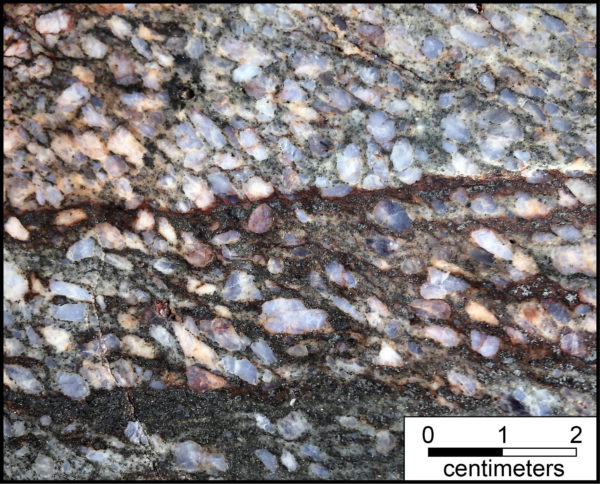
A close-up of view of the rock known as ‘Baby Blue’, it’s a metamorphosed sandstone/conglomerate. Note the distinctive blue-gray quartz clasts.
This blog post focuses on information obtained from one sample, in particular; we refer to the rock as ‘Baby Blue’ out of admiration for its distinctive blue-gray quartz clasts that comprise much of the rock. ‘Baby Blue’ was first discovered by the Gladstone Gladiators as part of their summer research campaign, way back in the pre-COVID world of 2019. ‘Baby Blue’ formed a small outcrop (~1 m wide by 30 cm tall) at the edge of an eroded-out roadbed off an old logging trail.
I first visited the ‘Baby Blue’ outcrop while conducting fieldwork on a muggy July day. At the outcrop we measured the orientation of geological structures and collected an oriented chunk of the pebbly quartzite to bring back to Williamsburg. However, ‘Baby Blue’ is not just eye-candy. Its preserved primary and secondary structures provide us with an opportunity to learn more about the depositional environment and later deformation. In metamorphosed and deformed rocks, primary structures are commonly obliterated, but ‘Baby Blue’ is special☺
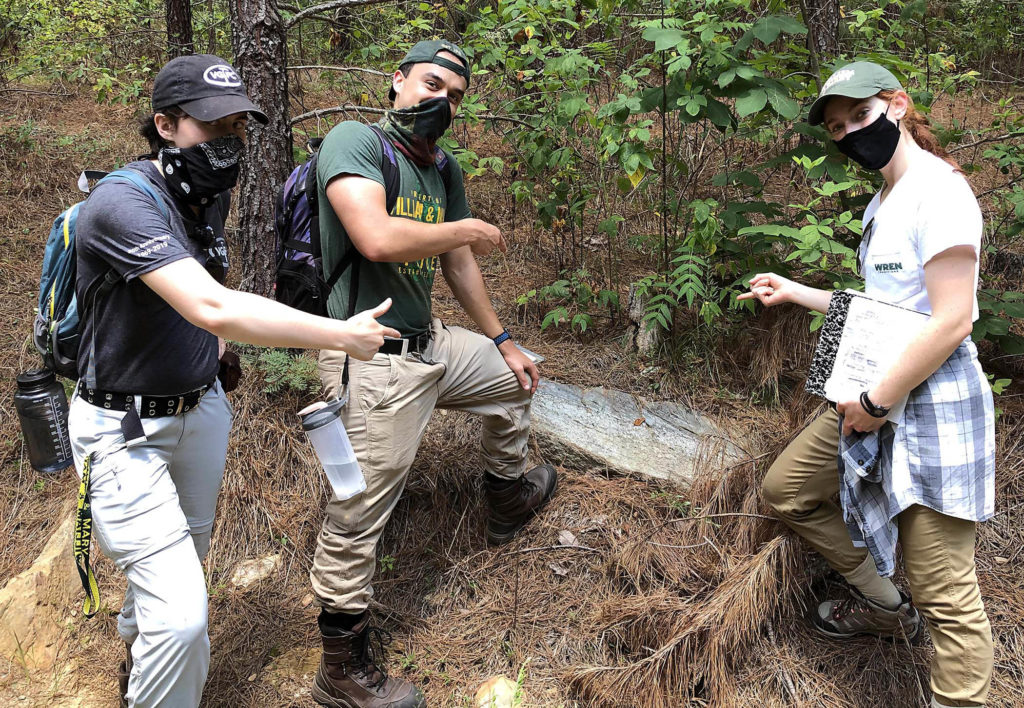
The itty-bitty ‘Baby Blue’ outcrop in the wilds of central Virginia. William & Mary geologists (from left to right) Terri Zach, Gabe Mojica, and me.
The primary structures include 1) bedding along a wavy contact between a conglomerate and sandstone, 2) cross bedding in the sandstone, and 3) weak grading in the conglomerate. Cross beds indicate that the sand grains were both transported and deposited by flowing water.
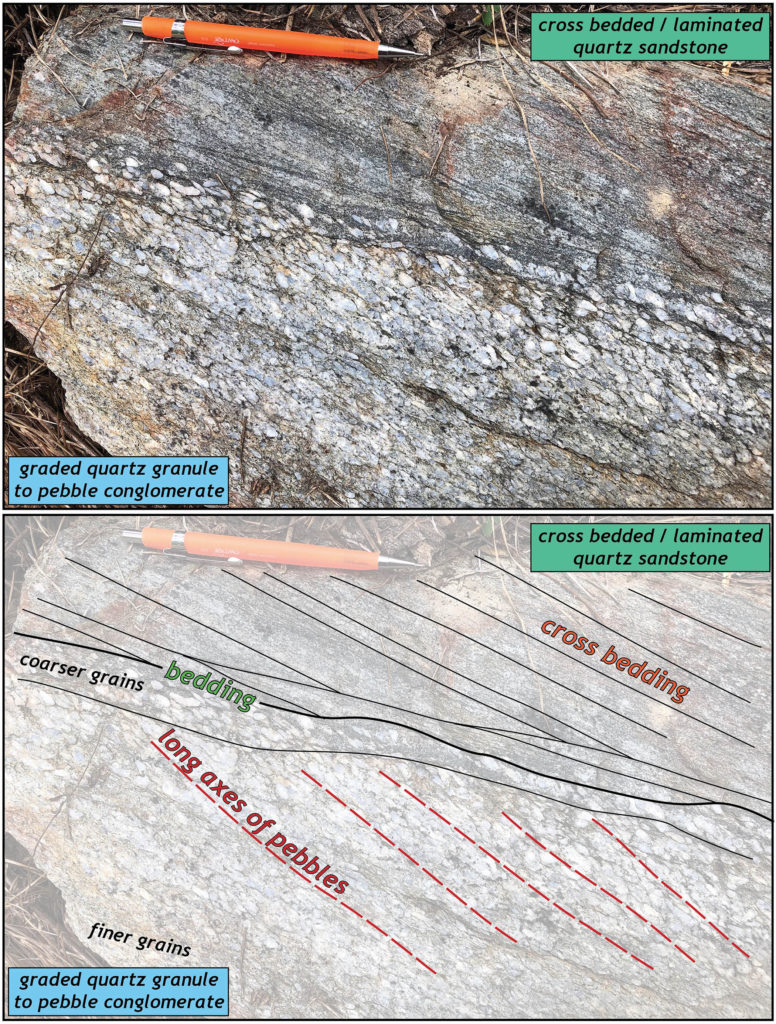
Outcrop picture of ‘Baby Blue’ with annotations of important primary and secondary structures. Select the image for a bigger and more expansive view.
A close look at the coarser quartz pebbles indicates they have a preferred orientation with their long axes aligned. Does this mean they were deposited in this orientation? Sometimes pebbles can be imbricated during deposition, but these are distinctly elongate pebbles- this implies that the grains’ shape was distorted by deformation long after the sediment was deposited. My research task is to determine just how much deformation these pebbles and granules underwent related to the orogenic events that occurred after their deposition.
Sediment is typically deposited one layer at a time with the younger layers above (overlying) older layers. By this “Law of Superposition” it would follow that the sandstone in ‘Baby Blue’ is younger than the conglomerate but upon closer examination of the layers’ relation to one another, we see something that suggests otherwise.
Some of the sedimentary layers cross-cut other layers, resulting in the older layers being truncated by the younger features. But in the ‘Baby Blue’ outcrop some of the cross beds are truncated at the bottom which suggests the rock at the bottom of the outcrop is actually a younger layer than the layer at the top! Below, I’ve rotated the image 180˚to better illustrate the original orientation of these strata before they were overturned.
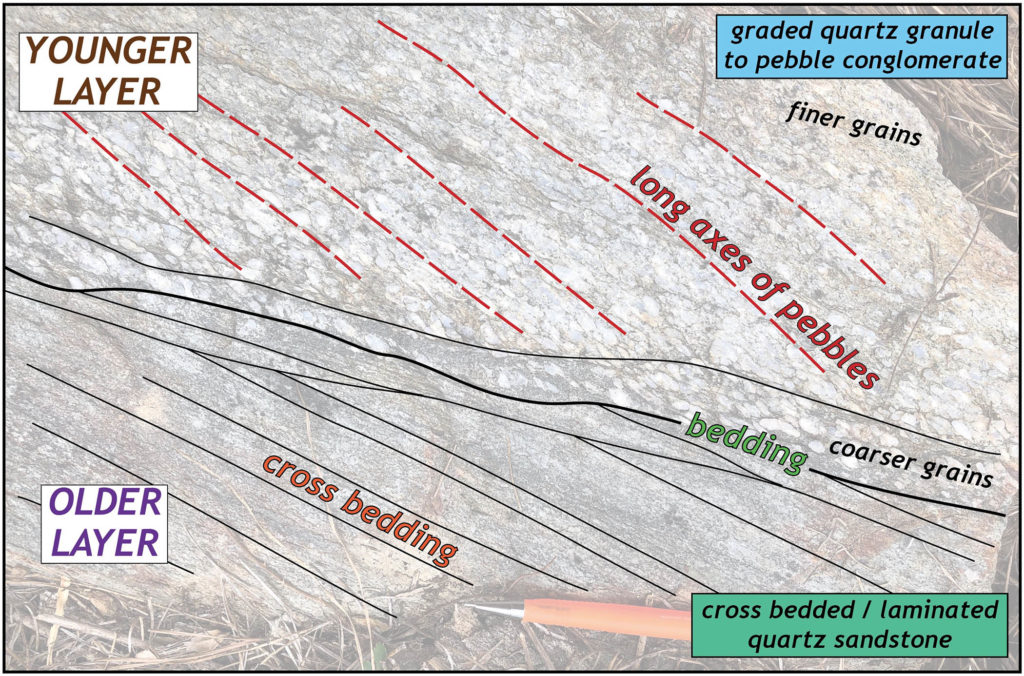
Image of ‘Baby Blue’, rotated 180˚such that the older layer (the sandstone) is below the younger layer (conglomerate). Select the image for a bigger and more expansive view.
By looking at these primary structures, we can see that these layers were overturned in such a way that the entire stratigraphy is inverted from its original depositional position – what some in the W&M Structural Geology & Tectonic Research Group might call- “tectonic monkey business.”
But how much strain did ‘Baby Blue’ enjoy?
Deformed pebbles are excellent strain markers. Sediment grains deposited in lake, river, or marine environments are typically nearly spherical in shape due to the rolling motion that occurs by long-distance transports in water. I estimated two-dimensional strain using the Rf/phi method which required that I trace many of the pebbles and measure the aspect ratio and orientation of individual grains for the entire grain population. Based on the data for that population I can estimate the strain ratio (Rs) and its orientation for a given section or rock face.
On the slab below, you can observe the numerous well-aligned and elongate bluish quartz pebbles. Some of these grains have an aspect ratio of >5:1 (that means they are 5 times longer than they are wide). Typically, pebbles that occur in a stream or along a beach are much closer to being equant in shape, yet these pebbles are strongly elliptical in shape.
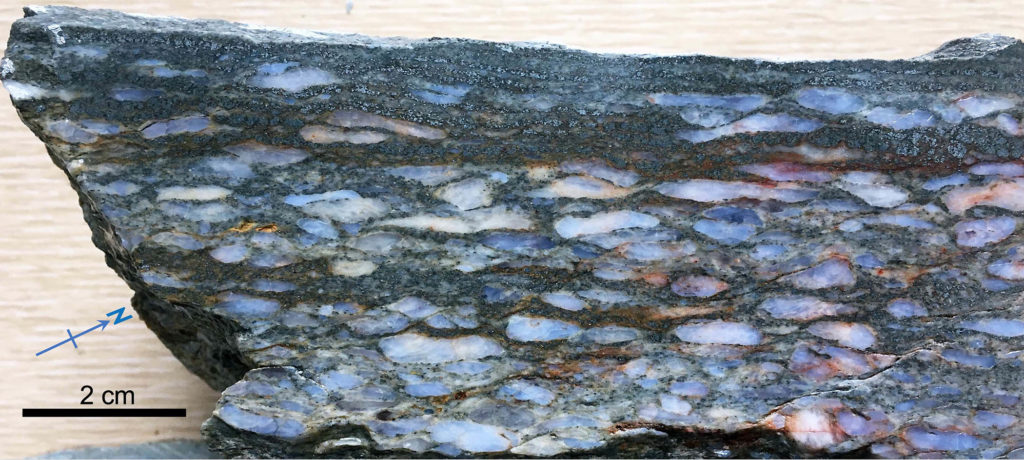
Polished slab from ‘Baby Blue’ with elongate blue quartz pebbles. Primary laminations are evident at the top of the slab.
Based on the population of grains, I estimate a strain ratio (Rs) of 3.6:1 for this particular section. An originally circular passive marker (the dashed white circle) would have been transformed into an ellipse with an aspect ratio of 3.6 (the red strain ellipse) which requires an elongation of the rock by ~90% (with an equivalent amount of shortening in the opposite direction). That’s some significant strain!
I measured strain on multiple two-dimensional surfaces and combined those data into a 3D estimate of the strain ellipsoid. The strain recorded by ‘Baby Blue’ is that of a moderately prolate ellipsoid – imagine an elongate egg.
But what does this say about the bigger picture? The map below illustrates the maximum strain ratios for multiple samples with the red strain ellipses plotted in their correct geographic orientation. Note that the long axes of the individual strain ellipses are oriented northeast-southwest, approximately parallel to the different rock units in the region.
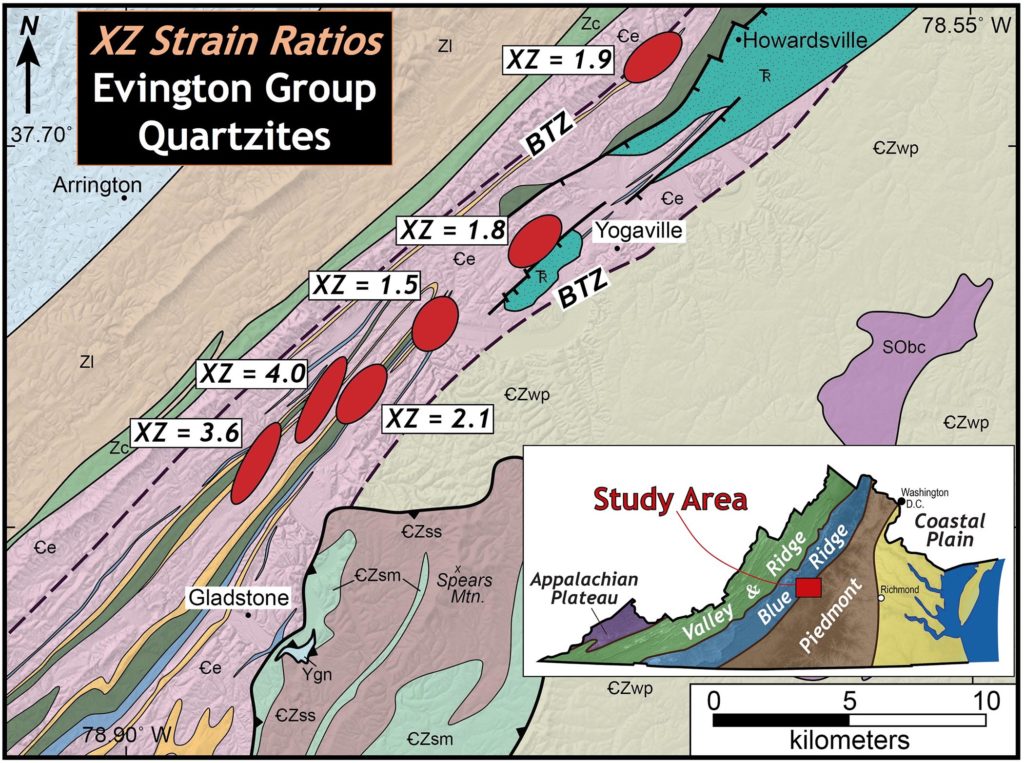
Regional geologic map of central Virginia with strain ratios for quartzite samples (red ellipses) from the Evington Group.
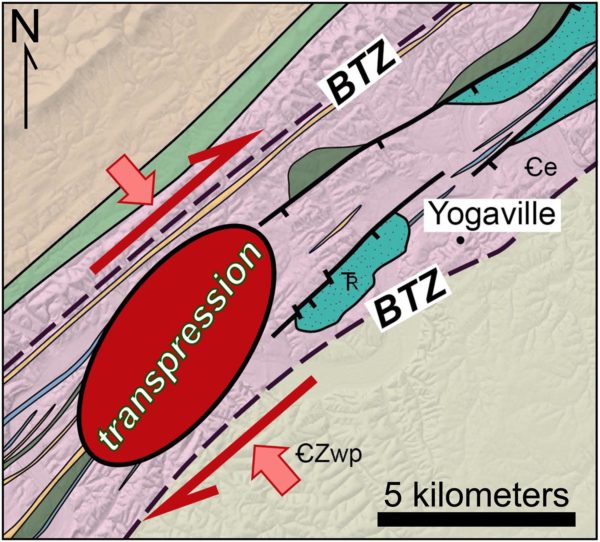
A close-up map of the Buckmarlson Transition Zone (BTZ) illustrating the general pattern of strain in the zone.
The strain and kinematic data from a suite of samples like ‘Baby Blue’ provides the evidence that these deformed and metamorphosed sedimentary rocks were both squeezed and wrenched during the Appalachian orogeny. More specifically, the style of deformation was that of transpression, a complex 3D flow of material in which the rocks were shortened, elongated, and sheared. This is likely the result of an oblique collision, rather than a head on collision, between ancestral North America and colliding plates during the late Paleozoic.
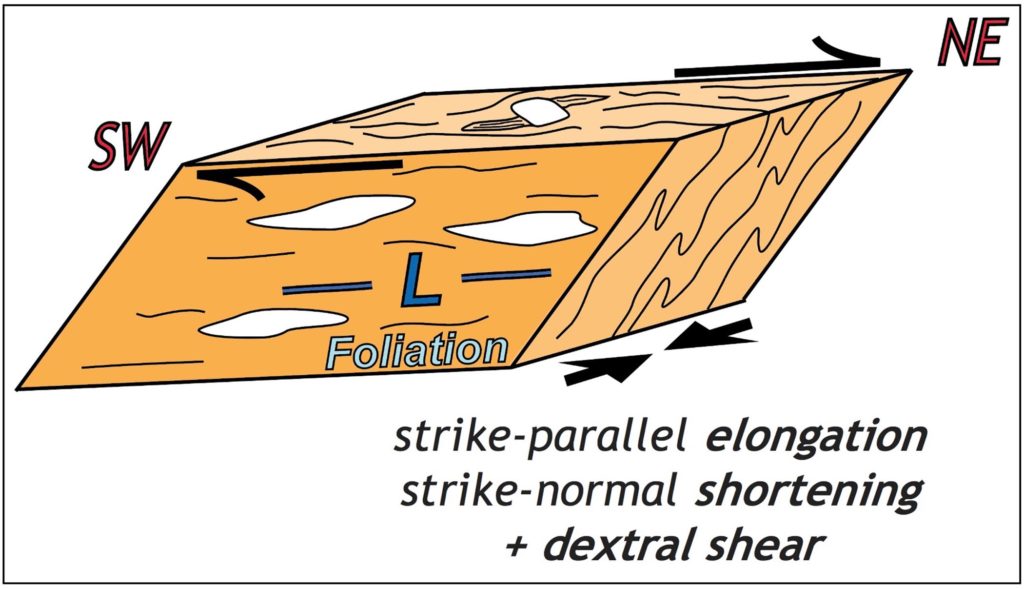
Conceptual model for 3D strain as recorded in rocks of the eastern Blue Ridge, central Virginia. L – lineation in the rock.
I transferred to William & Mary as a junior with the intention of being a geology major, but not fully understanding my reasoning as to why I’d study geology. Soon after my arrival I found my research advisor and picked a structural research problem in the Lofoten Islands of northern Norway for my thesis study. The pandemic changed my research plans, and now I am studying the geology a bit closer to home than originally planned!
I was bummed about not going to Norway, but I got to spend my time at William & Mary studying two different (and complex) structural geology phenomena. The research into these topics has made it clear as to why I am in geology – the analysis of small structures can shed light on the big picture events from the past, and I find that pretty amazing! I never considered doing my own scientific research before coming to William & Mary, but I am so thankful for that opportunity and I have loved the challenge.
As for ‘Baby Blue’, that chunk of quartzite now resides on campus in the Geology Rock Garden where it’s baby blue quartz clasts and awesome geological structures can be appreciated by all who visit. Next time you find yourself at the west end of the Sunken Garden, venture just a bit further and check out the Rock Garden.
Comments are currently closed. Comments are closed on all posts older than one year, and for those in our archive.

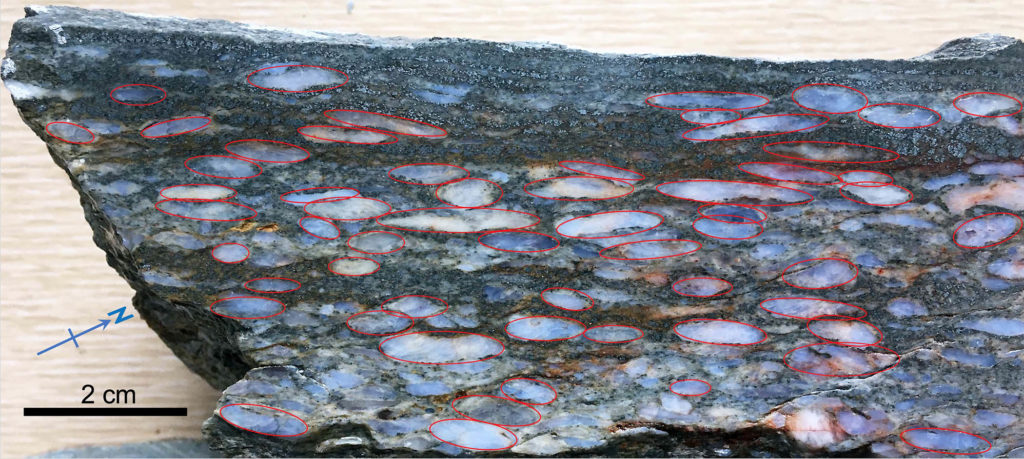
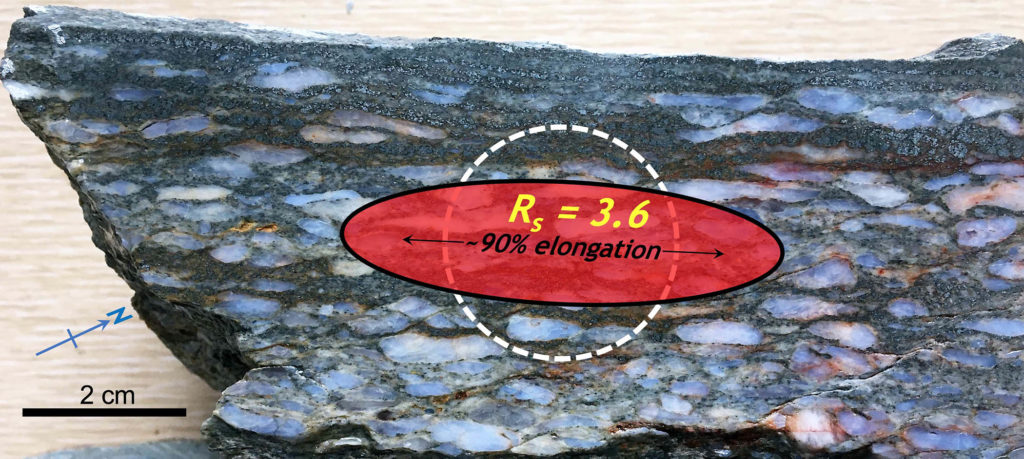
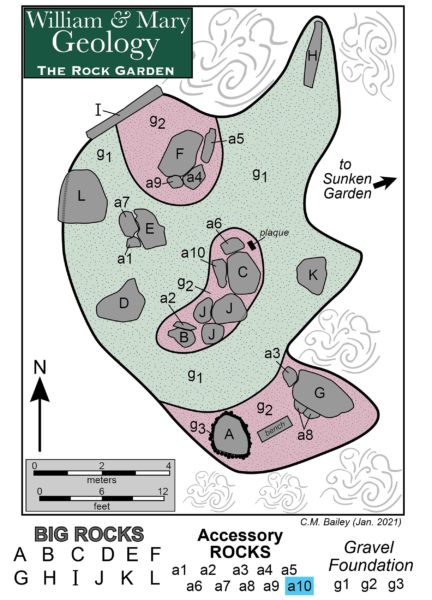

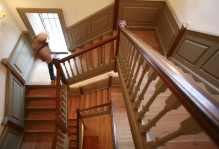

This is phenomenal OJ! I’m so happy I was apart of this years Structure group with you and got to see how you’ve worked this project. Also Baby Blue is a modern marvel, and I’m honored to have been apart of the retrieval team for her!
That is a lot of strain! I’m happy to know someone out there is working hard to figure out what these rocks have been getting up to.
This is stellar work Olivia. The overlays of the primary & secondary structures is great – nicely done!
Hmm I seem to remember a Baby Yoda loving professor recording Gabe, Jerry and I perilously retrieving Baby Blue from the field; odd that the recording is no where to be found #ReleaseTheFootage
This is an incredible blog post. Top 3 of all time for me. Your diagrams are informative, intuitive, and most of all, they are certainly “eye-candy”.